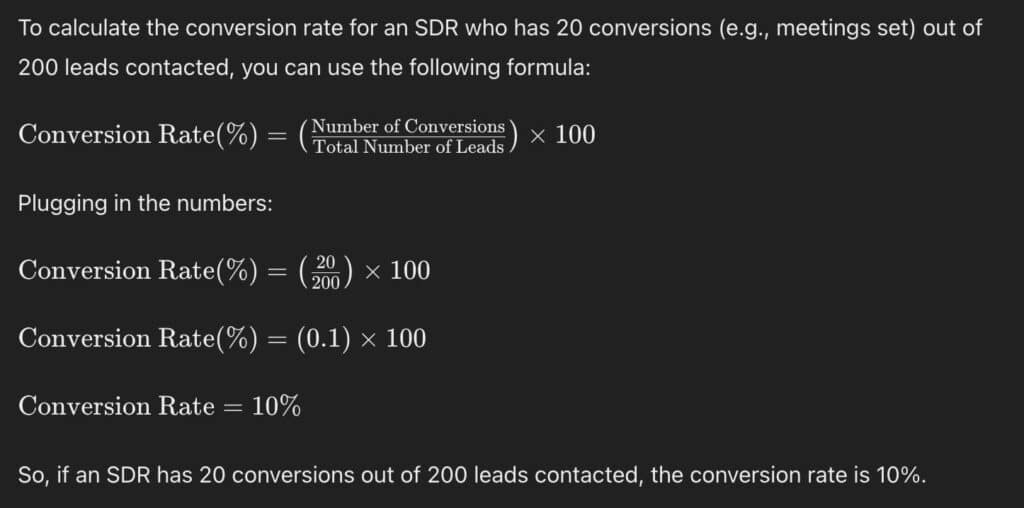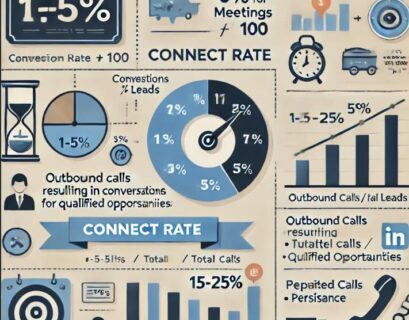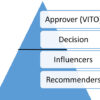As a Business Development Representative (BDR), knowing your numbers is crucial. One of the most important metrics you need to track and understand is your conversion rate. This metric provides deep insights into your effectiveness in moving prospects through the sales funnel. Let’s explore the steps to calculate your conversion rate, why it matters, and how it can improve your performance.
Understanding Conversion Rates
Steps to Calculate Conversion Rate
- Identify the Number of Conversions: This is the number of leads that have successfully been converted into the desired action, such as booking a meeting, making a purchase, or qualifying as a sales opportunity.
- Identify the Number of Leads: This is the total number of potential leads or prospects that were contacted or engaged during the specific period being measured.
- Apply the Formula: Divide the number of conversions by the number of leads, then multiply the result by 100 to get the percentage.
Example Calculation

Practical Application
- Marketing Campaigns: Evaluate the effectiveness of different marketing campaigns by comparing their conversion rates.
- Sales Processes: Optimize sales processes by identifying which strategies yield the highest conversion rates.
- Performance Metrics: Track and compare the performance of individual BDRs or sales teams based on their conversion rates.
Understanding and improving conversion rates can significantly enhance the efficiency and effectiveness of your sales and marketing efforts, leading to better business outcomes.
The Importance of Connect Rates
Definition and Relevance
Connect Rate: The percentage of outbound calls that result in a conversation with a decision-maker. This metric is crucial for BDRs as it directly influences the success of their outreach efforts.
Why It Matters
High connect rates indicate effective targeting and efficient use of time, while low rates suggest issues with the calling strategy, target list quality, or call timing.
Factors Influencing Connect Rates
- Targeting: Ensuring that BDRs are reaching out to the right contacts within the right organizations. Accurate and up-to-date data on prospects is essential.
- Call Timing: The time of day and day of the week can significantly impact connect rates. Research suggests that calling during specific times, such as late mornings or early afternoons, tends to yield better results.
- Personalization: Personalized messaging and understanding the prospect’s needs can increase the likelihood of engagement.
- Multi-Channel Approach: Combining calls with emails, LinkedIn messages, and other touchpoints can enhance the chances of connecting with prospects.
- Persistence: The number of attempts made to reach a prospect. It often takes multiple attempts to achieve a connection.
Strategies to Improve Connect Rates
- Data Quality: Regularly update and clean the contact database to ensure accuracy. Use tools and services that provide verified contact information.
- Optimizing Call Times: Analyze historical data to identify the best times to call specific industries or roles. Experiment with different times to find the optimal windows.
- Personalization and Preparation: Equip BDRs with personalized scripts and relevant information about the prospect. Understanding the prospect’s business challenges and industry trends can make the conversation more engaging.
- Training and Coaching: Continuous training on objection handling, call scripts, and conversation techniques. Role-playing exercises can help BDRs become more confident and effective.
- Technology Utilization: Use dialers and CRM tools to streamline the calling process and provide insights into call patterns and outcomes. Tools like Outreach, Salesloft, and HubSpot can offer valuable data for optimization.
Measuring and Analyzing Connect Rates
- Metrics Tracking: Regularly track connect rates alongside other key performance indicators (KPIs) like call volume, conversion rates, and meeting set rates.
- A/B Testing: Conduct A/B tests on different scripts, call times, and outreach strategies to determine what works best.
- Feedback Loop: Create a feedback loop where BDRs can share insights from their calls, helping to refine strategies and approaches.
Understanding and tracking your conversion rates and connect rates is essential for improving your performance as a BDR. By mastering these metrics, you can identify strengths and weaknesses in your approach, optimize your outreach strategies, and ultimately increase your effectiveness. Regularly reviewing these metrics in your 1:1 sessions with managers will not only help you stay on track but also prepare you for a successful transition to an Account Executive (AE) role.
By incorporating these best practices into your daily routine, you’ll be better equipped to track your performance, understand your impact, and continuously improve your sales techniques. This proactive approach not only enhances your current role but also sets you up for future success in the field.
Understanding and applying these formulas and strategies will ensure you’re always ahead of the curve, ready to meet and exceed your sales targets.











